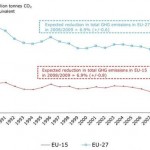Background to Data Used in this Statement
This preliminary information for 2010 is based on climate data from networks of land-based weather and climate stations, ships and buoys, as well as satellites. The data are continuously collected and disseminated by the National Meteorological and Hydrological Services (NMHSs) of the 189 Members of WMO and several collaborating research institutions. The data continuously feed three main depository global climate data and analysis centres, which develop and maintain homogeneous global climate datasets based on peer-reviewed methodologies. The WMO global temperature analysis is, thus, principally based on three complementary datasets. One is the combined dataset maintained by both the Hadley Centre of the UK Met Office and the Climatic Research Unit, University of East Anglia, United Kingdom. Another dataset is maintained by the National Oceanic and Atmospheric Administration (NOAA) under the United States Department of Commerce, and the third one is from the Goddard Institute of Space Studies (GISS) operated by the National Aeronautics and Space Administration (NASA). Preliminary November 2010 information is drawn from the ERA-Interim re-analysis-based data set maintained by the European Centre for Medium-Range Weather Forecasts (ECMWF). The content of the WMO statement is verified and peer-reviewed by leading experts from other international, regional and national climate institutions and centres before its publication.
Final updates and figures for 2010 will be published in March 2011 in the Annual WMO Statement on the Status of the Global Climate.
Notes:
1. The +/- 0.11°C uncertainty has been calculated from the HadCRU data set only. It is likely that the uncertainty for the three data sets combined is marginally lower than this but this has not been quantified.
2. Uncertainty margins for 2005 and 1998 are +/- 0.10°C.
3. The ERA-Interim re-analysis is produced by the European Centre for Medium-Range Weather Forecasts (ECMWF).
4. The sub-regions used in this report are those defined by the IPCC (available at http://www.ipcc.ch/ipccreports/tar/wg1/fig10-1.htm), with some regional names slightly modified. Sub-regional temperature anomalies are drawn from the HadCRU data set.
5. According to a Moscow city health official quoted by the AFP news agency (http://www.terradaily.com/reports/Russian_heatwave_caused_11000_deaths_in_Moscow_official_999.html).

About WMO
The World Meteorological Organization (WMO) is a specialized agency of the United Nations and the UN system’s authoritative voice on the state and behaviour of the Earth’s atmosphere, its interaction with the oceans, the climate it produces, and the resulting distribution of water resources. WMO has a membership of 189 Member States and Territories (as on 4 December 2009). It originated from the International Meteorological Organization (IMO), which was founded in 1873. Established in 1950, WMO became the specialized agency of the United Nations in 1951 for meteorology (weather and climate), operational hydrology and related geophysical sciences. For more information, visit www.wmo.int.













